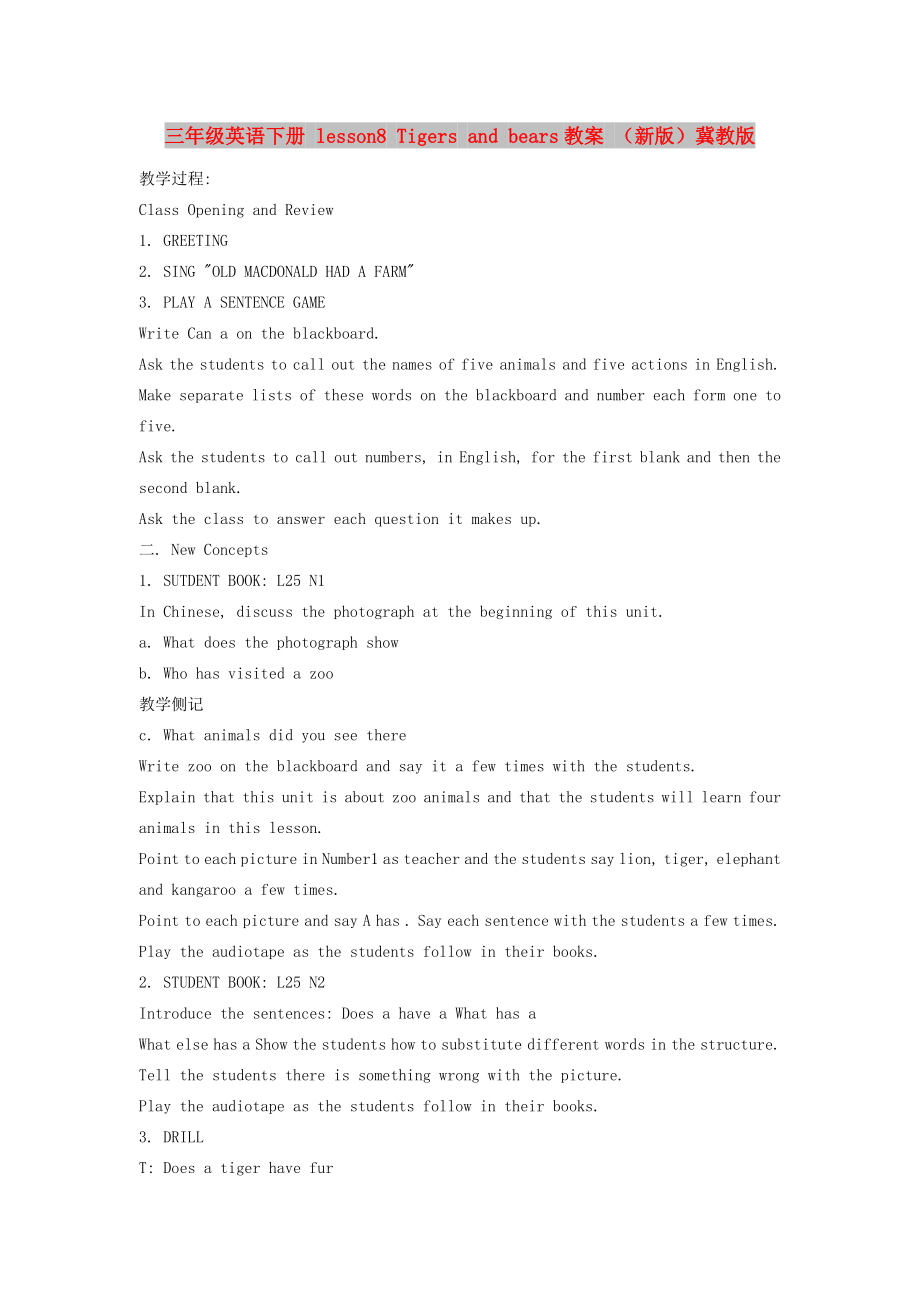《三年級(jí)英語(yǔ)下冊(cè) lesson8 Tigers and bears教案 (新版)冀教版》由會(huì)員分享�,可在線閱讀�����,更多相關(guān)《三年級(jí)英語(yǔ)下冊(cè) lesson8 Tigers and bears教案 (新版)冀教版(3頁(yè)珍藏版)》請(qǐng)?jiān)谘b配圖網(wǎng)上搜索�。
1���、三年級(jí)英語(yǔ)下冊(cè) lesson8 Tigers and bears教案 (新版)冀教版
教學(xué)過(guò)程:
Class Opening and Review
1. GREETING
2. SING "OLD MACDONALD HAD A FARM"
3. PLAY A SENTENCE GAME
Write Can a on the blackboard.
Ask the students to call out the names of five animals and five actions in English. Make separate lists of these word
2����、s on the blackboard and number each form one to five.
Ask the students to call out numbers, in English, for the first blank and then the second blank.
Ask the class to answer each question it makes up.
二. New Concepts
1. SUTDENT BOOK: L25 N1
In Chinese, discuss the photograph at the beginning o
3�����、f this unit.
a. What does the photograph show
b. Who has visited a zoo
教學(xué)側(cè)記
c. What animals did you see there
Write zoo on the blackboard and say it a few times with the students.
Explain that this unit is about zoo animals and that the students will learn four animals in this lesson.
Poi
4����、nt to each picture in Number1 as teacher and the students say lion, tiger, elephant and kangaroo a few times.
Point to each picture and say A has . Say each sentence with the students a few times.
Play the audiotape as the students follow in their books.
2. STUDENT BOOK: L25 N2
Introduce the sen
5、tences: Does a have a What has a
What else has a Show the students how to substitute different words in the structure.
Tell the students there is something wrong with the picture.
Play the audiotape as the students follow in their books.
3. DRILL
T: Does a tiger have fur
C: Yes, it does.
T:
6����、 Does a tiger have a trunk
C: No, it does not.
T: What has a truck
C: An elephant has a trunk.
三.Class Closing.
教學(xué)反思:
附送:
2019-2020年三年級(jí)英語(yǔ)下冊(cè) lesson8 Tigers and Beats教案 (新版)冀教版
教學(xué)目標(biāo):
一.知識(shí)目標(biāo)
1.? vocabulary: tiger ,wolf, bear, snake, long, short
2.? sentence: It’s--------. Its------
7�����、-is ------.
3.? Song: Big and Small
二、能力目標(biāo)
通過(guò)學(xué)習(xí)本課知識(shí)����,學(xué)生能夠熟練運(yùn)用句型“It’s--------. It’s-------is ------.
并用有趣、恰當(dāng)?shù)膭?dòng)作演唱歌曲“big and small.”,從而培養(yǎng)學(xué)生運(yùn)用英語(yǔ)的能力�����。
Emotional Attitude:
培養(yǎng)學(xué)習(xí)英語(yǔ)的興趣��,能積極的學(xué)習(xí)英語(yǔ)�����,養(yǎng)成愛(ài)聽(tīng)��、愛(ài)說(shuō)英語(yǔ)的習(xí)慣���。
Teaching Key Points:
1.? Students can listen, speak, read and write the words: tiger ���,wolf,
8��、 bear, snake ,
2.? Students can use the sentences: It’s--------. It’s-------is ------.
4.? Students can sing the song: “Big and Small.”
Teaching Difficulties:
Students can use the sentences: It’s--------. It’s-------is ------.
三���、Teaching Preparation: 教學(xué)準(zhǔn)備
Some pictures, ppt.
四�、Tea
9、ching Procedure: 教學(xué)步驟
(一). Lead in導(dǎo)入
1. Greeting.
2. Review.
1. sing the song “ big and small”
2. game: the missing game
What do you see? I see____. Now, what’s missing?
(二). New concepts
Step1: 1.????? tiger ����,wolf, bear, snake,
當(dāng)學(xué)生找不到再有什么動(dòng)物有皮毛的時(shí)候,引出 wolf
T: look, this is a wolf
10�����、. 在四線格里板書(shū)wolf, 領(lǐng)讀并安排學(xué)生不同形式的讀�,
強(qiáng)調(diào)“l(fā)” 在單詞中的發(fā)音。 滲透這個(gè)單詞復(fù)數(shù)的特殊變法�。
T: look, who is ing? 引出tiger
S: 板書(shū)并領(lǐng)讀
T: what do you see? I see a tiger
T: is it thin?
Ss: No. it’s fat.
(三)Riddle: it’s brown or black. 學(xué)生試著猜一猜。
It’s very fat.
引出bear 板書(shū)并領(lǐng)讀�����,生拼讀����,用手蓋上字母“b”,幫助學(xué)生記憶。
Step2: pract
11�����、ice
Game: 教師準(zhǔn)備一組動(dòng)物的單詞條和一組身體部位的單詞條,讓生分別抽出一個(gè)�����,組成句子����, (教師引導(dǎo)學(xué)生自己?jiǎn)栆恍﹩?wèn)題,開(kāi)動(dòng)腦筋�,結(jié)合以前學(xué)過(guò)的知識(shí),教師可以提示tail, paws, wings, feathers, beak…培養(yǎng)學(xué)生綜合語(yǔ)言運(yùn)用能力)
Step3: pair work:
完成書(shū)上的表格���,教師先與生做示范���。
T: does a wolf have
小組合作時(shí),教師監(jiān)督生用英語(yǔ)交流�����,培養(yǎng)學(xué)生愛(ài)說(shuō)英語(yǔ)的習(xí)慣�����。
Step 4. 學(xué)習(xí)歌曲big and small
Homework:
1.????? 制作其他身體部位的表格�,和同學(xué)交流。
2.????? 把歌曲唱給同伴或家人���。
五�����、板書(shū)設(shè)計(jì):
Lesson 8: Tigers and Beats
? tiger ����,wolf, bear, snake, long, short
It’s--------. Its-------is ------.
 三年級(jí)英語(yǔ)下冊(cè) lesson8 Tigers and bears教案 (新版)冀教版
三年級(jí)英語(yǔ)下冊(cè) lesson8 Tigers and bears教案 (新版)冀教版

